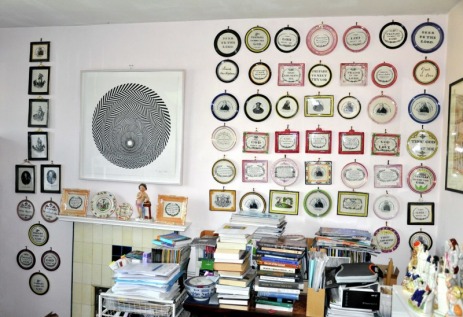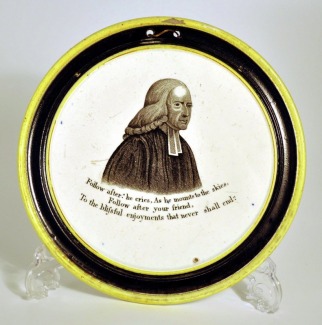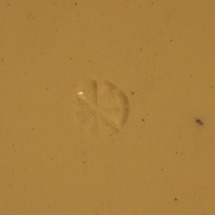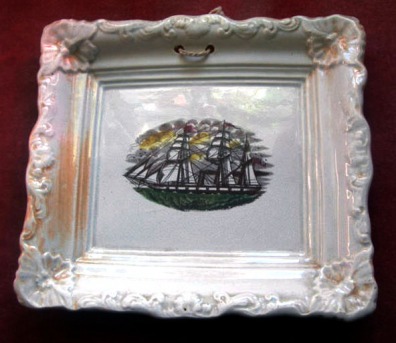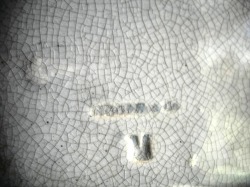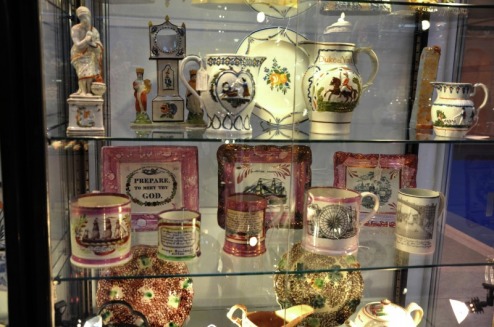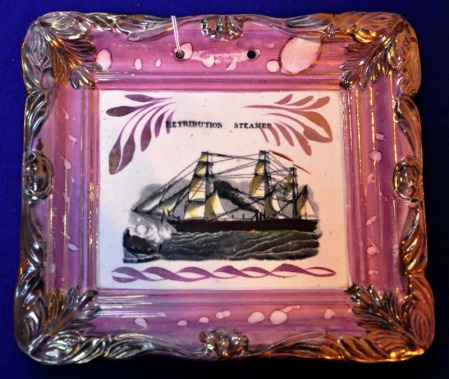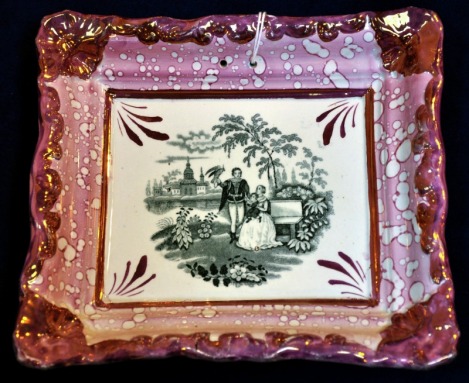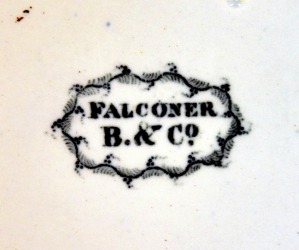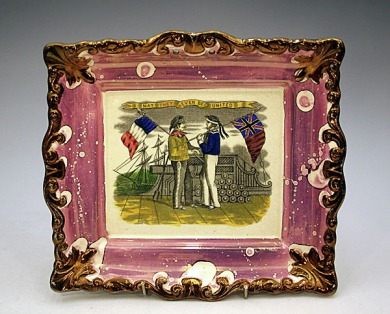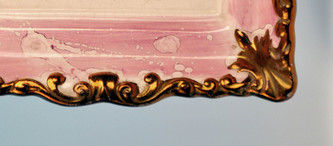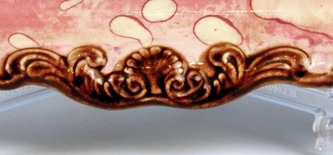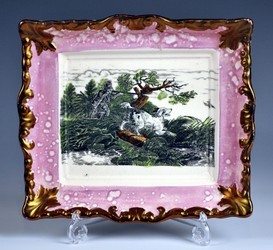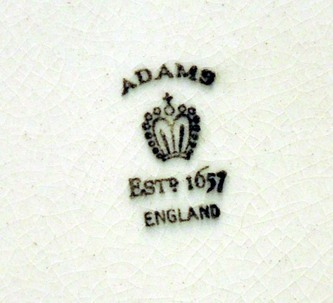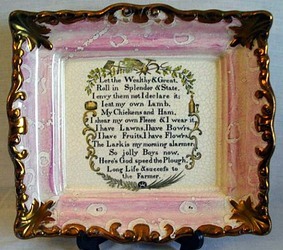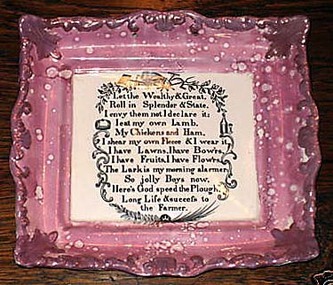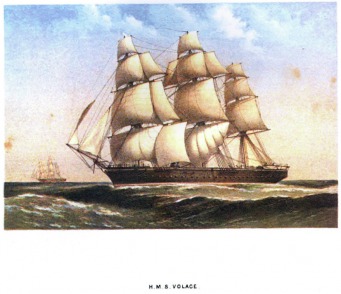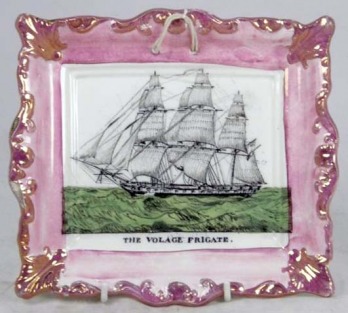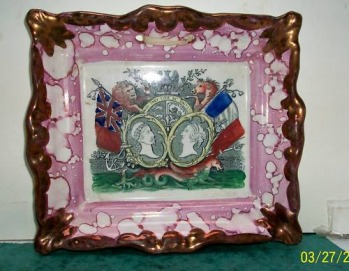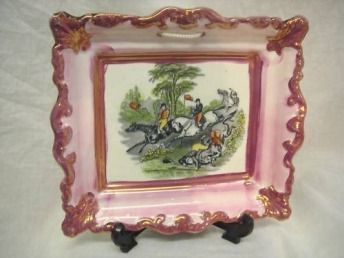|
4/23/2010 0 Comments 50 more religious plaques addedI've spent today photographing and posting on-line a superb private collection of religious plaques. Their owner is a friend, who'd rather remain anonymous. My thanks to him for a highly enjoyable day. Though most of the new photos are on the religious pages, don't miss John Knox and Robert Raikes on the portraits page, and several additions to the poetic verses page. The Wesley above has an interesting mark, like a plate full of sliced cake, which someone might be able to identify.
0 Comments
4/21/2010 0 Comments Orange ship plaqueOther than the occasional 'Albion' marked plaque, there's a tendency to attribute anything with orange borders to Ball's Deptford Pottery. The plaque below, which came up on eBay this week, says otherwise. Although the mark is difficult to read (below), it appears to be 'MOORE & Co'. This is supported by the impressed 'M' beneath it. Also, there are many pink lustre plaques of this form, with 'MOORE & Co' impressed on them. According to Baker, Moore's pottery closed down in 1874. Ball's Pottery made orange lustre wares, just over the river, around the 1870s. It therefore seems probable that this plaque was made towards the end of Moore's production period, although the modelling still looks reasonably crisp. It would be interesting to know how heavily potted it is - earlier plaques tend to be lighter. Odd plaques like this with impressed or printed marks, can add hugely to our knowledge. If any collectors reading this have similar plaques, please get in touch.
Although eBay refused to act when we reported the shill bidding patterns of 1079edmund, it seems Trading Standards take a much more serious view. A Yorkshire seller faces up to £50,000 fines for bidding up his own items using different eBay accounts. 'Shill bidding' is standard practice for some antiques sellers on eBay. If you think you've been the victim of shill bidding, complain to your local Trading Standards Office! The full story below:
http://news.bbc.co.uk/1/hi/england/8632331.stm Thanks to the many people who've been in touch regarding the story in the Antiques Trade Gazette (see last post). One correspondent, Ted Knowle, provided some excellent advice on detecting fake painting: Hello.... I came across your warning about over-painted lustre ware on ebay more or less by accident --- very interesting. But, as you will know, the perpetrator is not unique. There will be less blatant and more skillful operators out there who also realise how easy it is to 'add value', especially by simply hand-tinting a transfer. It is pretty easy. I know because I was a professional restorer. Although modern repair materials, such as epoxy resins and bake-on lacquers, give a very hard repaired/retouched surface, as far as I know they are still not as hard as fired ceramic glazes and enamels. True fired-on pottery enamels are often described as 'soft' because they are coloured glazes with a lower melting point, but they are still hard and glassy in nature. Paint, whatever kind, is not quite as hard as that. The basic (non-damaging test) is simply to lightly run the finger tips over the suspect area: fresh paint has a slight 'drag', especially if thick (try it out on newly painted woodwork at home to get the feel) but this becomes less noticeable with age. If a special bake-on (meaning kitchen oven heat) lacquer has been used there will be far less 'drag'. The suspect area may well be slightly warmer to the touch than unpainted ceramic. A needle point will scratch paint, but with care -- you can scratch/damage almost anything with a hard enough point and enough pressure. It is not generally recommended to use paint stripper, nor bleach, on gilding --- either might affect it (it is thin soft metal, usually fired at low temperature) and the lustre is a very thin soft coating, almost a gas-like layer. A tiny drop of cellulose (car paint) thinner can rapidly soften most paints. In the case of lustre-ware, as you say, it is not easy to replicate the thin sheen but there are new products coming into the craft shops all the time, so be aware. Watch this space! On Friday I'm photographing a large collection of religious plaques. I hope to start adding images on Saturday, all being well.
The Antiques Trade Gazette has run the story of 1079edmund's enamel-faking activities (see my March 23 & 25 postings below): http://www.antiquestradegazette.com/news/7498.aspx.
Thanks also to Peter Searle for preserving the original eBay listing on his Sunderland Site. Though I doubt they'll respond, it would be interesting to hear eBay's reaction to the story. 4/11/2010 0 Comments NEC Antiques For EveryoneThere were slim pickings for plaque hunters at the NEC. The photo below shows one of the cabinets on Roger de Ville's stand. The John Carr (attributed) Retribution Steamer below is in great condition. As is the unusual plaque below, with a printed mark on the reverse, 'Falconer', 'B. & Co.'. For anyone who missed these plaques at the NEC, they will be travelling to Harrogate for the Antique and Fine Art Fair, April 29 to May 03, 2010.
4/8/2010 0 Comments Borders without shellsThe plaque below was apparently produced around 1855 at the time of the Crimean War. The border is unusual. It has particularly crisp scolled edges, but without a hint of the shell motif which appears on nearly all larger-sized rectangular plaques (see right image below – click to enlarge). This Crimean plaque looks to be 19th century, as does the 'Express' plaque with a landscape and a train (see landscapes), which also has this scrolled edging. (The Express plaques on this site have pink outer edges, but versions with copper edges also exist. For a pink-edged version of the Crimean plaque, see the other maritime page.) I don't know of any plaques with this edge that have impressed marks, so it's difficult to attribute them to a particular pottery. Confusingly, however, this edging has also been used on 20th century reproductions (see the hunting plaque below), albeit with less crisp scrolling. The mark on the reverse is from Adams' Staffordshire pottery. It was used at their Greenfield site 1914–1955, and at their Greengates site 1914–1970. Precisely when this plaque was made is, therefore, anyone's guess. The other plaque I've seen with this form of edging is the 'Success to the farmer' verse below. The plaque on the left has an all-over crackle, often associated with reproductions, but according to the owner, the lustre looks right. The plaque on the right has pink edges. If anyone knows of other plaques with this scrolled edging, or has one with an impressed mark, please get in touch. Also, I'd love to know if anyone can confirm whether the 'Success to the farmer' (on the left) is original or a reproduction. P.S.For an update, please see my January 2012 post on the subject.
4/1/2010 0 Comments A case of mistaken identityWith many ships sharing the same name, picking the right one is not always as straightforward as it seems. On the rare ships page, I identified 'The Volage Frigate' with the screw-iron corvette launched on 27 February 1869. But solely on the basis of its similarity to the illustration below. Dick Henrywood, who recently purchased the plaque below, writes: I've had further thoughts about the Volage and wonder if your website identification of the ship built in 1869 is correct. That does seem rather late for the plaque, and looking at the print it seems to have only twelve guns on each side and doesn't look steel hulled. The previous Volage was built in Portsmouth in 1825 and was a 28-gun ship. This ties up much better with the pictured vessel, allowing for the odd gun or two facing fore and aft. This vessel was involved in a Battle with China (the Battle of Chuanbi) in the first Opium War of 1839-42. I just think this sort of date is much more likely for the plaque. With his engineering background, Dick is much better qualified than me to identify the ship. What he says makes sense from a pottery point of view. The Volage in my collection has scalloped corners. Plaques of that form appear with other transfers known to be from the 1840s. Whereas the later ship would have placed the plaque towards the end of the period in which plaques were produced. I've adjusted the text in line with the new attribution.
I'm always very happy to hear from anyone who can improve the quality of information on this site: [email protected] 4/1/2010 0 Comments Not all bad on eBayI'm conscious that my posts about 1079edmund might be damaging to other eBay sellers, so, for the sake of balance, here are two superb plaques currently on eBay. They are both highly coloured with genuine Victorian enamels. I haven't seen the items, so be sure to ask all your normal questions about damage and restoration before bidding. Below a Crimean war plaque: 230456378539. You can see similar items on the other maritime page. The next plaque is a Moore & Co hunting scene: 260578482659. You can see more from this series on the landscapes page.
|
AuthorStephen Smith lives in London, and is always happy to hear from other collectors. If you have an interesting collection of plaques, and are based in the UK, he will photograph them for you. Free advice given regarding selling and dispersal of a collection, or to those wishing to start one. Just get in touch... Archives
February 2022
AcknowledgementsThis website is indebted to collectors, dealers and enthusiasts who have shared their knowledge or photos. In particular: Ian Holmes, Stephen Duckworth, Dick Henrywood, Norman Lowe, Keith Lovell, Donald H Ryan, Harold Crowder, Jack and Joyce Cockerill, Myrna Schkolne, Elinor Penna, Ian Sharp, Shauna Gregg at the Sunderland Museum, Keith Bell, Martyn Edgell, and Liz Denton.
|
